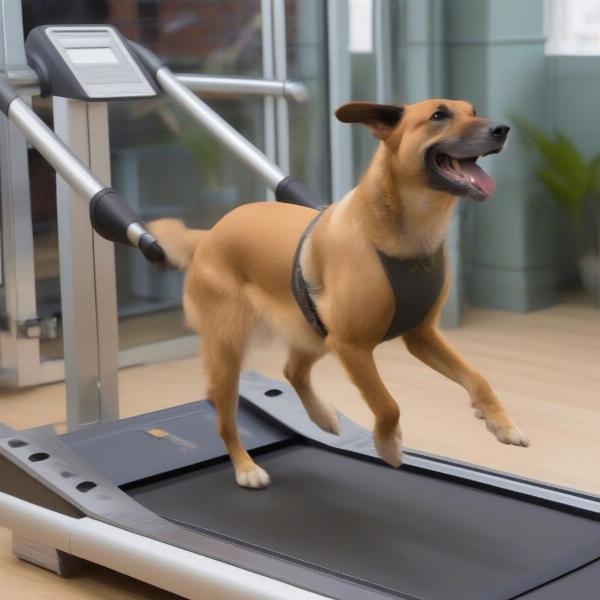The dog runner, also known as a dog treadmill, provides a controlled and safe environment for your canine companion to exercise. Whether you’re dealing with inclement weather, limited outdoor space, or a high-energy dog needing an outlet, a dog runner can be a valuable tool. This guide will delve into the benefits, different types, and how to choose the right dog runner for your furry friend.
 Dog Running on a Treadmill
Dog Running on a Treadmill
Benefits of Using a Dog Runner
A dog runner offers a plethora of benefits beyond just physical exercise. It helps stimulate their minds, curb destructive behaviors born from boredom, and can even aid in weight management. For working dogs or those in training, it’s an excellent way to maintain peak physical condition. Regular exercise on a dog runner can also improve cardiovascular health, strengthen muscles, and increase endurance.
Choosing the Right Dog Runner
Selecting the appropriate dog runner depends on various factors, including your dog’s breed, size, and energy levels. Smaller breeds will require a smaller running surface, while larger, more energetic dogs will benefit from a larger, more robust machine. Consider features like incline adjustments, speed control, and safety features such as side panels and emergency stops.
Types of Dog Runners
Dog runners come in two main varieties: manual and motorized. Manual treadmills require the dog to power the belt themselves, offering more resistance and a more challenging workout. Motorized treadmills, on the other hand, allow you to set the pace, ideal for rehabilitation, endurance training, or dogs less inclined to self-motivate.
Introducing Your Dog to the Dog Runner
Patience is key when introducing your dog to a dog runner. Start slowly, allowing them to sniff and investigate the machine. Use positive reinforcement, treats, and praise to create a positive association. Never force your dog onto the treadmill. Gradually increase the speed and duration of sessions as they become more comfortable.
Safety Precautions
While dog runners are generally safe, certain precautions should be taken. Always supervise your dog while using the machine. Ensure the treadmill is placed on a stable surface. Start with short sessions and gradually increase the duration as your dog builds stamina.
Maintaining Your Dog Runner
Regular maintenance will ensure the longevity and optimal performance of your dog runner. This includes cleaning the belt, lubricating moving parts, and checking for any signs of wear and tear.
Is a Dog Runner Right for My Dog?
Dr. Emily Carter, a certified canine rehabilitation specialist, notes, “A dog runner can be an invaluable tool for maintaining a dog’s physical and mental well-being, but it’s essential to assess individual needs and ensure proper introduction and usage.” If you have concerns about your dog’s health or suitability for using a dog runner, consulting with your veterinarian is always recommended.
Conclusion
The dog runner offers a versatile and effective way to provide your dog with the exercise they need. By carefully considering your dog’s needs and following safety guidelines, you can ensure a positive and beneficial experience for both you and your furry friend. Remember to start slowly, use positive reinforcement, and consult with your veterinarian if you have any concerns.
FAQ
- How long should my dog use the dog runner? Start with short sessions (5-10 minutes) and gradually increase the duration as your dog’s fitness improves.
- What type of dog runner is best for my puppy? Consult your veterinarian before introducing a puppy to a dog runner. If recommended, start with very short, supervised sessions on a manual treadmill.
- Can I leave my dog unattended on the dog runner? Never leave your dog unsupervised on a dog runner.
- What should I do if my dog seems hesitant to use the dog runner? Use positive reinforcement and patience. Never force your dog onto the treadmill.
- How often should I clean my dog runner? Clean the belt after each use and lubricate moving parts according to the manufacturer’s instructions.
- Is a dog runner a replacement for outdoor walks? While a dog runner provides excellent exercise, it shouldn’t entirely replace outdoor walks, which provide essential mental stimulation and socialization.
- What are some signs that my dog is enjoying the dog runner? A relaxed posture, wagging tail, and willingness to get on the treadmill are all positive signs.
About ILM Dog
ILM Dog is your premier online resource for expert advice on dog care and breeds. We offer practical guidance on dog health, training, nutrition, grooming, and much more. Whether you’re a seasoned dog owner or just starting out, ILM Dog provides reliable information and valuable insights to help you nurture a happy and healthy canine companion. Contact us today for personalized advice: Email: [email protected], Phone: +44 20-3965-8624.